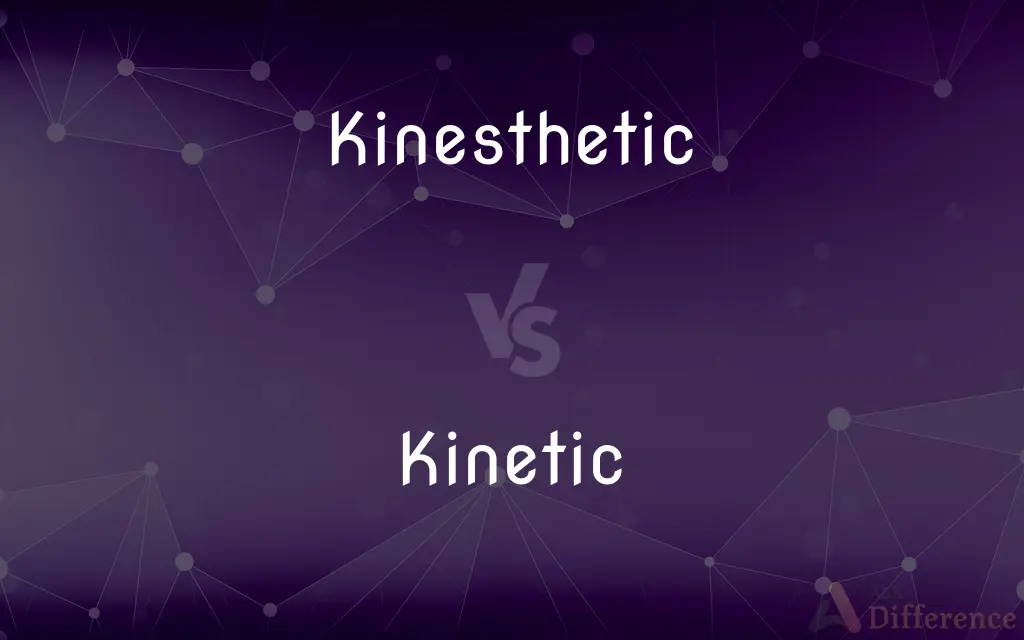Kinesthetic vs. Kinetic — What's the Difference?
By Fiza Rafique & Maham Liaqat — Updated on March 26, 2024
Kinesthetic involves bodily movements and the perception of such movements, while kinetic relates to the motion of objects and the forces acting upon them.

Difference Between Kinesthetic and Kinetic
Table of Contents
ADVERTISEMENT
Key Differences
Kinesthetic learning focuses on physical activities as a method of understanding and remembering information, using the sense of bodily movements. On the other hand, kinetic energy is a concept in physics that measures the energy an object possesses due to its motion.
The kinesthetic approach is often applied in educational settings, emphasizing hands-on activities, whereas kinetic concepts are utilized in scientific fields, particularly in mechanics, to analyze and predict the motion of objects.
While kinesthetic skills are crucial for activities requiring body awareness such as dance and sports, kinetic principles are fundamental in engineering and technology, influencing the design of machines and vehicles.
Kinesthetic intelligence is one of the multiple intelligences proposed by Howard Gardner, highlighting the ability to control body movements and handle objects skillfully. Conversely, kinetic theory explains the behavior of gases, attributing their macroscopic properties to the motion of molecules and atoms.
Individuals with high kinesthetic awareness are often adept at tasks requiring fine motor skills, whereas an understanding of kinetic energy can lead to innovations in energy conservation and management.
ADVERTISEMENT
Comparison Chart
Definition
Relating to the perception of body movements
Relating to the motion of objects
Field of Use
Education, psychology
Physics, engineering
Key Focus
Bodily movements and awareness
Forces and motion of objects
Application
Learning styles, physical education
Mechanics, energy conservation
Examples
Dance, sports
Wind turbines, moving vehicles
Compare with Definitions
Kinesthetic
Relating to learning through physical activities.
Kinesthetic learners prefer hands-on experiments over listening to lectures.
Kinetic
Pertaining to the motion of objects under the influence of forces.
Kinetic energy is converted into electrical energy in a hydroelectric power plant.
Kinesthetic
Involving the sense of muscle movement.
Yoga improves one's kinesthetic awareness by focusing on precise body movements.
Kinetic
Focused on the physical aspects of motion.
In physics class, we calculated the kinetic energy of rolling spheres on inclined planes.
Kinesthetic
Pertaining to the perception of body position and movement.
Dancers have excellent kinesthetic intelligence, allowing them to perform complex routines.
Kinetic
Relating to the energy possessed by a moving object.
The kinetic energy of a bullet is high due to its high speed and mass.
Kinesthetic
Associated with tactile learning styles.
Using clay in art class can enhance students' kinesthetic learning experience.
Kinetic
Concerned with the principles of objects in motion.
Engineers use kinetic equations to design safer automobiles.
Kinesthetic
Focused on physical engagement in the learning process.
Kinesthetic teaching methods involve active participation, like building models or role-playing.
Kinetic
Involving the study of dynamics and motion.
Kinetic sculptures move and change, creating an interactive art experience.
Kinesthetic
The sense that detects bodily position, weight, or movement of the muscles, tendons, and joints.
Kinetic
Of, relating to, or produced by motion.
Kinesthetic
Of or relating to kinesthesia.
Kinetic
Relating to motion.
Kinesthetic
Of or relating to kinesthesis
Kinetic
Relating to or exhibiting kinesis.
Kinetic
Relating to kinesis or motor function.
Kinetic
(biology) Relating to the movement of an organism in response to an external stimulus.
Kinetic
(philosophy) Relating to the force driving life forward.
Kinetic
Relating to active warfare or the use of lethal force.[W]
Kinetic
(slang) frantic; busy.
Kinetic
Moving or causing motion; motory; active, as opposed to latent.
Kinetic
Relating to the motion of material bodies and the forces associated therewith;
Kinetic energy
Kinetic
Characterized by motion;
Modern dance has been called kinetic pantomime
Kinetic
Supplying motive force;
The complex civilization of which Rome was the kinetic center
Common Curiosities
Can someone be both kinesthetically intelligent and have a good understanding of kinetic principles?
Yes, an individual can have both a high kinesthetic intelligence, being adept at controlling their body movements, and a strong understanding of kinetic principles, applying them in scientific contexts.
What is kinetic energy?
Kinetic energy is the energy that an object possesses due to its motion.
How do kinesthetic activities benefit learners?
Kinesthetic activities engage learners physically, making learning experiences more memorable and effective for those who prefer hands-on approaches.
What is kinesthetic learning?
Kinesthetic learning is a method that involves physical activities to facilitate understanding and retention of information.
Are kinesthetic skills naturally inherited or can they be developed?
While some individuals may have a natural predisposition towards kinesthetic skills, these can certainly be developed through practice and training.
Why is kinetic energy important?
Kinetic energy is important because it plays a crucial role in various physical phenomena and technological applications, from generating electricity to the functioning of vehicles.
What factors affect an object's kinetic energy?
An object's kinetic energy is affected by its mass and the square of its velocity.
What advancements have been made in kinetic energy storage?
Advancements in kinetic energy storage include flywheel energy storage systems, which store energy in a spinning mass.
How do kinesthetic and kinetic concepts differ in application?
Kinesthetic concepts are primarily applied in education and psychology, focusing on learning and movement perception, whereas kinetic concepts are used in physics and engineering to analyze motion and forces.
How do educators incorporate kinesthetic learning in classrooms?
Educators incorporate kinesthetic learning by including physical activities, hands-on experiments, and movement-based tasks in their lesson plans.
In what ways are kinesthetic intelligence and kinetic theory utilized in real-world scenarios?
Kinesthetic intelligence is utilized in professions requiring fine motor skills and body awareness, while kinetic theory is applied in understanding and designing systems involving gas behavior and thermal dynamics.
How does kinesthetic awareness contribute to sports performance?
Kinesthetic awareness contributes significantly to sports performance by allowing athletes to control their movements precisely and react intuitively during play.
Can kinetic concepts explain all forms of motion?
Kinetic concepts are fundamental in explaining many forms of motion, though complex systems may require additional theories for full understanding.
Are there any limitations to kinesthetic learning methods?
Kinesthetic learning methods may not be as effective for learners who prefer auditory or visual information, and they require space and resources not always available in traditional classroom settings.
What distinguishes kinetic energy from potential energy?
Kinetic energy is associated with motion, while potential energy relates to an object's position or state that could lead to motion.
Share Your Discovery

Previous Comparison
Info vs. Information
Next Comparison
Conflict vs. CrisisAuthor Spotlight
Written by
Fiza RafiqueFiza Rafique is a skilled content writer at AskDifference.com, where she meticulously refines and enhances written pieces. Drawing from her vast editorial expertise, Fiza ensures clarity, accuracy, and precision in every article. Passionate about language, she continually seeks to elevate the quality of content for readers worldwide.
Co-written by
Maham Liaqat














































